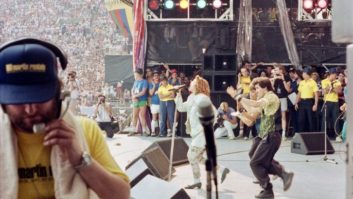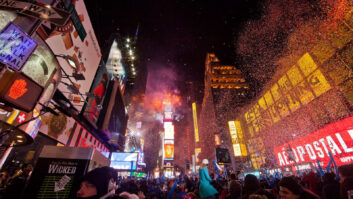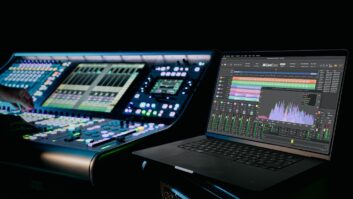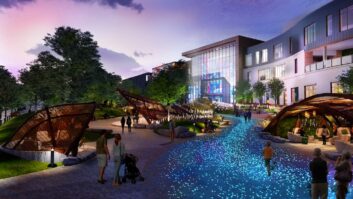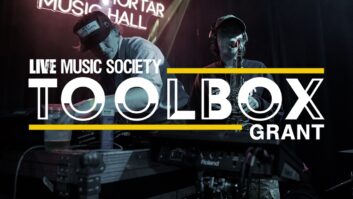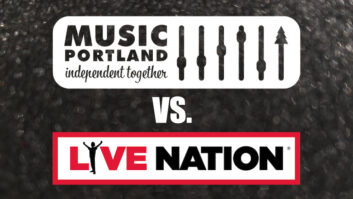New York, NY (July 17, 2018)—Since kicking off her current 70-date Melodrama World Tour in September last year, Lorde has been circling the globe; having already hit the U.S. this past spring, she’ll play Australia’s Byron Bay this Friday. Covering the FOH position throughout the lengthy run, which stretches on to this coming November, engineer Philip J. Harvey has been mixing on an SSL L500 Plus console outfitted with extensive plug-ins from Waves, and for her non-festival arena dates, he’s been mixing the show through a L-Acoustics’ L-ISA system
Key to the show, of course, is Lorde’s vocal. Harvey noted, “You know, before I first started working with Lorde, I thought, ‘This could potentially be a light singer where I might have to step in and compensate for shortcomings in her vocal delivery,’ but that is definitely not the case. She is a very strong singer, producing a lot of volume and character, which is great because you have a solid foundation to sculpt her voice into a powerful instrument. As a live mixing engineer, it’s a real bonus to be working with someone who really stands out with her natural talent.”
That foundation starts with a DPA d:facto 4018LV handheld microphone, going into the SSL’s onboard hi-pass filter and EQ, whereupon vocals are run into a plug-in chain using Waves MultiRack; the chain starts with the Waves Renaissance DeEsser, going to the Waves C6 Multiband Compressor and then to Waves Aphex Vintage Aural Exciter.
Harvey added, “Lorde has a bit of a baritone quality to her voice, so for me, it’s just an issue of attenuating the low-mid range, which can get pretty thick in the mix sometimes. The C6 nicely shapes and contains her voice subtly without any undesirable artifacts. C6’s two floating bands take care of most of the processing, with the first floater attenuating the low-mids in her voice around 170 Hz in the 5 dB range, and the second floater narrowly catching any sibilants that might escape the DeEsser within a 3 dB range. The first stationary low-band is used to attenuate low-end frequencies below the first floating band at 2 to 3 dB, and the fourth high-band expands the highs 1 to 2 dB to bring back some presence post-de-essing. For that sparkle on the vocal, I used to boost the top end with an EQ and maintain it with a de-esser, but doing that would increase the potential for sibilance when she was on the mic. I often found that when you hit the vocal with the de-esser too hard, it can sound unnatural. The Aphex Aural Exciter in conjunction with the C6 totally makes up for any potential dullness and adds a nice presence and vibe to it that I hadn’t discovered before.”
On creating the layered, widening vocal effects and textures heard on some of Lorde’s biggest songs, Harvey adds, “In my vocal effects chain, I like to use two different reverbs throughout the set via MultiRack: the Waves Abbey Road Reverb Plates for a short reverb to reinforce the tonality of her voice and give it some extra character, and the IR-Live Convolution Reverb with a longer reverb setting using the Sydney Opera House impulse response to give her voice even more depth and expansion.”
While it’s natural for any engineer to ensure that the singer’s vocal is the focal point of the mix, that’s not always the case with Lorde’s show, as Harvey noted: “Lorde doesn’t want her vocal on top of everything else; she likes the backing vocals even in the mix with her own voice. I love Vocal Rider for taking care of that. I use a 3dB range to keep it subtle, setting it between +1 to -2.”
Bringing that vocal to the audience for the arena shows was a sizable L-Acoustics L-ISA rig: “On this tour, we had the opportunity to try different things sonically. For the arena setup, we deployed a totally immersive 9.1 audio environment with processing and mapping to a multi-line array setup consisting of three [hangs of] 16 K2 plus two [hangs of] 21 Kara loudspeakers, with four [hangs of] 16 Karas as extension hangs and a pair of 8 K1 SB center-hung subwoofers. It basically allows me to separate and localize my sound sources wherever I want in the house, creating a clear and totally immersive landscape for every single person in the audience.”
In order to make the most of the L-ISA system in creating that immersive space for the audience, Harvey prepped rigorously. “Before I even got in front of the L-ISA system, I used the Waves Nx Virtual Mix Room [a virtual monitoring plug-in for emulating a three-dimensional panoramic stereo image on headphones] to experiment and develop a sketch of the mix in a 5.1 setup. It was totally helpful to try out new ideas in creating a landscape for the venues in my headphones way before even seeing the system for the first time.”
Waves • www.waves.com
